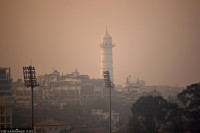Climate & Environment
Government says it has plan to tackle monsoon disasters, but local units are not assured
With rainfall expected to be above normal this year, authorities say they are better prepared than last year. But experts say rather than anticipatory plans, focus is on post disaster response.
Chandan Kumar Mandal
Last June, there were deadly landslides in Durlung of Kushma Municipality, Parbat. The first monsoon-induced disaster in the country of 2020 killed nine and displaced 13 families.
“We suffered loss of lives and properties on the very first day of the monsoon season,” Ram Chandra Joshi, mayor of Kushma Municipality, told the Post over the phone.
The municipality of 50,000 residents has still not fully recovered from last year's tragedy, and now it is bracing for this year’s monsoon—forecast for which is not reassuring.
“It has been raining lately and villagers are scared that there will be floods and landslides like last year,” said the mayor. “Our municipality has big rivers like Modikhola, Kaligandaki, Jaharekhola and Ratikhola and many other small streams which can quickly swell after rain. And as new roads have been built, there are chances of debris coming down and sweeping away whole settlements if there is too much rain.”
The forecast for this year’s monsoon, which entered the country on Friday, is that rainfall in most parts of the country will be “above normal”.
High mountains and mid hills will receive above normal rainfall, the central-southern districts and eastern Nepal will see normal rainfall and southeastern parts of the country will witness below normal rainfall.
In an effort to lessen the impact of the monsoon rains, the National Disaster Risk Reduction and Management Authority under the Home Ministry has prepared the National Monsoon Early Preparedness and Response Work Plan 2021.
It estimates that over 1.8 million people will be affected by monsoon-related disasters like flooding and inundation, embankment breach and slides—1,687,480 by floods and another 117,217 by landslides. Other monsoon hazards include thunderstrike, snake bite and water-borne diseases.
“The caseload of monsoon disasters has been calculated based on historical data on disasters, prediction and trend of rainfall and populations living around disaster-prone areas,” said Beda Nidhi Khanal, undersecretary at the Authority. “The action plan has been prepared considering the populations, which include both directly and indirectly affected groups.”
Of the 1.8 million people that the authority estimates will be affected, about 500,000 will be affected directly.
Changes in the rainfall patterns, which have become severe and erratic in the past few years as an impact of climate change, have contributed to extreme weather events like floods and landslides annually.
While the country's southern plains are battered by floods, hill districts have landslides.
On average, floods kill about 100 every year.
This year, the authority predicts that Sunsari, Rautahat, Sarlahi, Siraha and Kanchanpur districts will be the top five most flood-hit districts, with the affected population in each of these districts crossing 100,000. Likewise, Dolakha, Sindhupalchok, Bajura, Dhading and Doti districts are likely to be hit by severe landslides.
“The action plan also includes measures on how the impact of the monsoon can be minimised for the people,” said Khanal.
The central disaster management authority has stipulated the roles and responsibilities for various agencies concerned to minimise damage and losses and to provide quick response and relief to disaster-affected communities.
“The main objective of preparing the monsoon action plan is providing an estimation of disaster risk and mapping of the population at risk, identifying and assigning activities for authorities and officials concerned, and managing resources and coordination among various agencies,” said Bishwa Prasad Aryal, joint secretary with the authority. “The action plan also provides a basis on which provincial and local level governments can prepare their own action plans.”
The comprehensiveness of the action plan was the result of the extent of impact of the monsoon last year when it was predicted to be normal.
But its impact was the deadliest in many years. According to official figures, in the four months between June and October, 367 people died, 100 went missing and 325 others suffered injuries in various monsoon-induced disasters. As many as 293 people died in landslides, 39 in floods and 35 from lightning.
In comparison, in 2019, when it was a normal monsoon, 73 people died in floods and 83 in landslides.
Besides the above-normal rainfall this year, the massive forest fires earlier this year are expected to add to the scale of disasters.
“Forest fires this year have caused soil erosion, which will affect the flow of water, further increasing the risk of water-induced disasters," said Aryal.
Nepal is prone to monsoon-related disasters because many rivers and river networks are congested within a small area and the country's topography itself poses risk, according to Bishnudev Yadav, a senior divisional engineer at the Department of Water Resources and Irrigation.
“Therefore, we prepare against monsoon floods throughout the year. Soon after the monsoon ends, we start constructing structures like embankments and take other measures for fencing river banks like putting up walls of sand-filled sacks and gabion walls,” Yadav said.
Yadav said the department managed the construction of 44.7 km of embankment this fiscal year.
Government agencies say they are better prepared this year.
“Last year's monsoon made us realise what we could do better. After learning, analysing and reflecting for the rest of the year, we realised that our early preparedness for landslides had been nominal as our efforts were highly focused on floods,” said Anil Pokharel, chief executive officer of the authority. “We could minimise loss of lives and properties due to floods but could not do the same for landslides. There were no adequate relief materials targeting landslides.”
This time, the authority has also started impact-based forecasting of landslides at the ward level in 36 local units of nine districts, which will help early forecasting of landslides, according to Pokharel.
“Our decision-making is more data-driven this time. Before coming up with the monsoon action plan, there were consultations with stakeholders in all seven provinces,” said Pokharel. “We have improved our information system. For example, we have gathered information on existing helipads across the country, which will help us airlift the victims if required. Unlike in the past when various cluster agencies would get activated only after the disaster, they have already been activated this time.”
As the country is reeling under the second wave of Covid-19 pandemic, the action plan has also identified districts battling Covid-19 cases and facing a higher risk of floods and landslides this monsoon.
The action plan has also identified 155 open spaces in urban areas and 191 spaces and public buildings that can be used for rescue and rehabilitation purposes. Likewise, mapping of existing financial and logistical resources in different provinces have also been conducted.
A working procedure for providing relief and financial assistance to families who have lost their houses to monsoon-related disasters is in place this time.
The action plan has also outlined activities and responsibilities for all the ministries and various agencies in all three tiers of the government.
Experts have welcomed the government’s preparedness this year.
“This year’s monsoon response plan should be welcomed because it shows some coordinated efforts among different agencies. This time, they have also worked on a monsoon action plan earlier, which is a positive step,” said Madhusudan Gautam, a disaster and resilience expert.
However, these are easier said than done.
“Information system is still not as smooth as it should be. Also, there is limited equipment,” said Pokharel.
Other challenges include localisation of the plan, supply of resources to remote areas, data accuracy and its timely availability and coordinating joint actions for immediate relief, according to Aryal.
The lack of sufficient budget seems to be a major issue, according to authorities who work in the field.
Yadav, the senior divisional engineer, said there is never enough budget for emergency operations.
“Nearly Rs1.42 billion has been demanded from the districts ranging from Rs1.5 million to Rs15 million for emergency work, but we have not received the budget for this monsoon season,” said Yadav.
Funds seem to be an issue for Kushma Municipality too.
“We have made some preparations with the limited resources we have. The activities and benefits under the monsoon action plan reach the District Administration Office but we hardly get anything,” said Mayor Joshi. “When disaster strikes here, people lose their houses and are permanently displaced and require immediate relief. Budget is the main requirement.”
Like Kushma Municipality of Parbat, in Tilathi Koiladi Rural Municipality, Saptari, where flooding and inundation have been a perennial problem with the swelling of the Koshi and Khado rivers, budget is one of the major challenges.
However, river training programmes funded by the local government have largely minimised the risk of flooding in recent years, according to mayor Satish Kumar Singh.
He also says there are no funds from the central government to fight against monsoon-related disasters, making it difficult for carrying out disaster response and relief activities.
“Local units are burdened with too much work, but there is a limited budget,” Singh told the Post over the phone. “Half of the budget is spent on administrative purposes and programmes related to health, education, social development, leaving hardly anything for disaster preparedness and management. There should be a mechanism whereby a proportion of the budget of local governments must be spent exclusively for disaster preparedness and management.”
However, in Kathmandu, Pokharel said budget for carrying out rescue, response and recovery activities is not an issue.
“We have adequate budget. The Home Ministry has asked us to be quick and efficient with our activities without bothering about budget,” said Pokharel. “Besides, there is also the Prime Minister's Disaster Relief Fund which has Rs2-3 billion. Provincial governments also have their own funds for disaster response.”
Despite the National Monsoon Early Preparedness and Response Work Plan 2021 in place, Gautam, who is currently with the National Reconstruction Authority, feels anticipatory actions are not initiated before an impending crisis in order to minimise the worst effects or even avoid a crisis altogether.
“Preparations or activities ahead of disasters are very minimal. These are part of early preparedness. For instance, if there is a forecast of flooding days ahead and we know how many houses will be affected, we can relocate them before the disaster occurs,” said Gautam. “Our efforts still revolve around post-disaster response.”




 5.8200000000001°C Kathmandu
5.8200000000001°C Kathmandu










